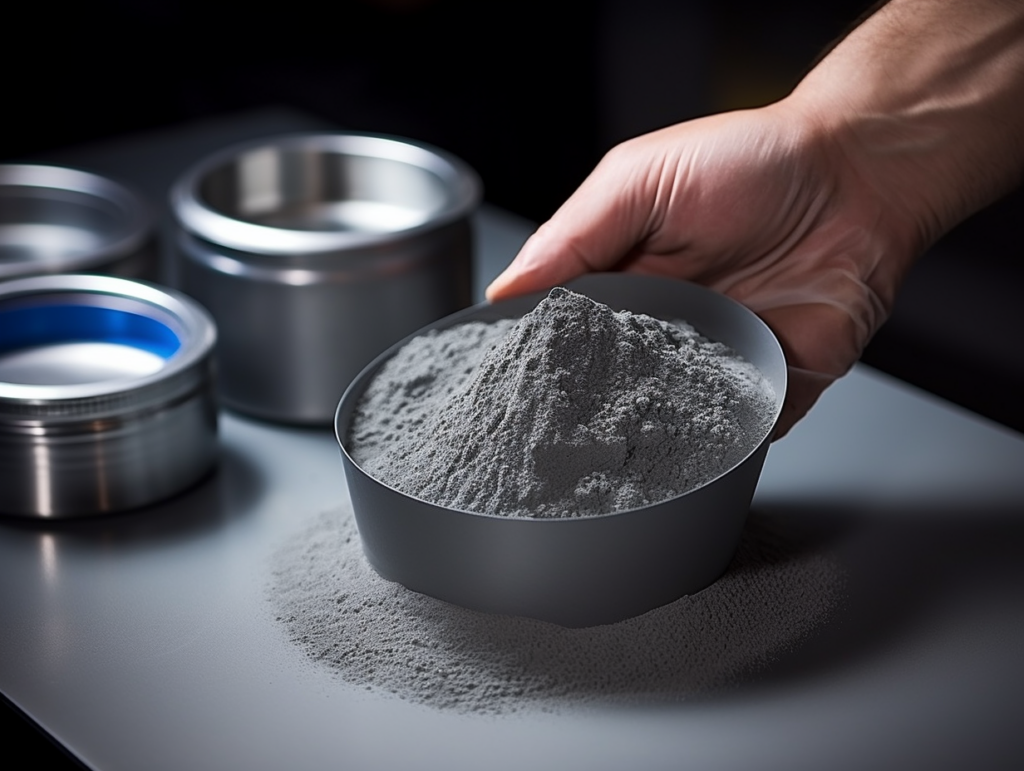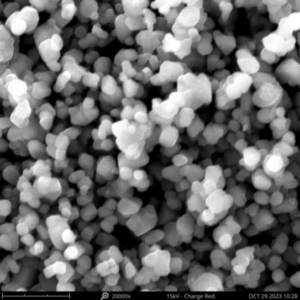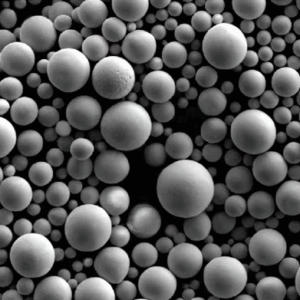The world of metal additive manufacturing, also known as 3D printing, is revolutionizing the way we design and produce complex parts. Imagine conjuring up a component on a computer and then having it materialize layer by layer in real life – that’s the magic of this technology. But this magic needs a special ingredient: metal powder.
Al 3104 powder is one such workhorse material, a superstar in the realm of aluminum alloy powders specifically designed for 3D printing applications. Let’s delve into its world, exploring its composition, properties, applications, and how it stacks up against other metal powder contenders.
Al 3104 Powder: A Compositional Breakdown
At its heart, Al 3104 powder is primarily composed of aluminum (Al), the lightweight metal we all know and love. But what makes it special for 3D printing is the addition of two key alloying elements:
- Manganese (Mn): Imagine Mn as the muscle builder in this metallic mix. A small amount of Mn enhances the overall strength of the material, making it more resistant to deformation under stress.
- Magnesium (Mg): This element acts like a processing wizard. A sprinkle of Mg improves the powder’s flowability, making it easier to spread evenly during the 3D printing process. This translates to smoother finishes and more consistent results.
The specific percentages of these elements can vary slightly depending on the manufacturer, but here’s a typical breakdown:
| Element | Percentage (wt%) | Role |
|---|---|---|
| Aluminum (Al) | Balance | Foundation material |
| Manganese (Mn) | 0.5 – 1.0 | Strengthener |
| Magnesium (Mg) | 0.2 – 0 .5 | Flowability enhancer |
Beyond the core trio, some manufacturers might add trace amounts of other elements for specific purposes. For example, copper (Cu) can be introduced to improve weldability, while silicon (Si) can enhance wear resistance.

Unpacking the Properties of Al 3104 Powder
So, what makes Al 3104 powder such a popular choice for 3D printing? Here’s a closer look at its key properties:
- Excellent Strength-to-Weight Ratio: Al 3104 offers a fantastic balance between being strong and lightweight. Compared to pure aluminum, it boasts a significant increase in strength without sacrificing much weight. This makes it ideal for applications where weight reduction is crucial, like in aerospace and automotive components.
- Superior Formability: The presence of Mg makes Al 3104 powder particularly flowable. This allows for the creation of intricate geometries with minimal issues during the 3D printing process. Think of it like working with soft, moldable playdough compared to a stiff, crumbly clay.
- Enhanced Corrosion Resistance: Aluminum itself is naturally corrosion-resistant, and the addition of Mn in Al 3104 powder further bolsters this property. This makes it suitable for applications exposed to harsh environments, like marine components or parts for outdoor equipment.
- Weldability: Al 3104 parts can be readily welded using traditional techniques, offering additional flexibility in post-processing and integration with other components.
It’s important to note that these properties can vary slightly depending on the specific printing process and post-processing techniques used. However, Al 3104 powder generally offers a consistent and predictable set of characteristics, making it a reliable choice for various applications.
Al 3104 Powder in Action: A Look at its Applications
The versatility of Al 3104 powder shines through in its diverse range of applications. Here are some key areas where it finds itself right at home:
- Aerospace: The lightweight and high-strength nature of Al 3104 makes it perfect for aerospace components where minimizing weight is paramount. It can be used for parts like brackets, housings, and even structural components in non-critical areas.
- Automotive: The automotive industry is constantly seeking ways to reduce vehicle weight and improve fuel efficiency. Al 3104 powder is used to create lightweight yet sturdy components like engine brackets, suspension parts, and even some interior components.
- Consumer Products: From camera parts to sporting equipment, Al 3104 powder is finding its way into various consumer products. Its ability to create complex geometries allows for the design of innovative and functional products.
- Medical Devices: The biocompatible nature of aluminum, coupled with the precision of 3D printing, makes Al 3104 powder suitable for certain medical applications.
Al 3104 Powder: A Look at its Competitors
While Al 3104 powder reigns supreme in many applications, it’s not the only player in the metal additive manufacturing game. Here’s how it stacks up against some of its most common competitors:
Metal Powder Contender: AlSi10Mg
- Composition: AlSi10Mg, as the name suggests, is an aluminum alloy powder containing silicon (Si) at around 10% and magnesium (Mg) at similar levels to Al 3104.
- Head-to-Head: AlSi10Mg offers superior weldability compared to Al 3104, making it a better choice for applications requiring frequent welding. However, its strength is slightly lower than Al 3104, and the higher silicon content can make it less flowable during printing, potentially leading to surface roughness issues.
Metal Powder Contender: 316L Stainless Steel
- Composition: 316L stainless steel powder is a popular option for applications requiring high corrosion resistance and strength. It contains chromium (Cr), nickel (Ni), and molybdenum (Mo), elements known for their excellent corrosion-fighting properties.
- Showdown: When it comes to corrosion resistance, 316L stainless steel reigns supreme. It outshines Al 3104 in environments with harsh chemicals or constant exposure to saltwater. However, it’s significantly heavier and more challenging to print due to its lower flowability. Additionally, 316L stainless steel powder requires a more controlled printing environment to avoid cracking during the process.
Metal Powder Contender: Inconel 625
- Composition: Inconel 625 powder is a nickel-chromium superalloy known for its exceptional high-temperature strength and resistance to harsh environments. It’s the go-to choice for parts operating under extreme heat and pressure.
- Strength vs. Super Strength: Inconel 625 blows Al 3104 out of the water when it comes to strength at elevated temperatures. However, it’s also the most expensive option on this list and requires specialized printing equipment due to its high melting point.
Choosing the Right Metal Powder
The selection of the ideal metal powder depends on the specific application’s needs. Here are some key factors to consider:
- Required Strength: How much stress will the component experience during operation? Al 3104 offers a good balance, while Inconel 625 excels in high-stress environments.
- Weight Constraints: Is minimizing weight a priority? Al 3104 shines in this category, while 316L stainless steel and Inconel 625 are considerably heavier.
- Corrosion Resistance: Will the component be exposed to corrosive elements? 316L stainless steel is the champion for corrosion resistance, followed by Al 3104 and then Inconel 625.
- Printability: How complex is the desired geometry? Al 3104’s good flowability makes it easier to print intricate shapes compared to some competitors.
- Budget: Metal powder costs vary significantly. Al 3104 is a relatively cost-effective option, while Inconel 625 comes with a premium price tag.
The Takeaway: There’s no one-size-fits-all answer when it comes to metal powders. Al 3104 stands out for its versatility, offering a good balance of strength, weight, printability, and cost. However, depending on the specific application requirements, other metal powders like AlSi10Mg, 316L stainless steel, or Inconel 625 might be better suited for the job.
Al 3104 Powder: Specifications, Sizes, and Grades
When working with Al 3104 powder, it’s crucial to consider the following specifications:
| Specification | Description | Importance |
|---|---|---|
| Particle Size Distribution (PSD): | This refers to the range of sizes of the powder particles. | A well-distributed PSD ensures good flowability and minimizes voids in the final printed part. |
| Sphericity: | This describes the shape of the powder particles. | Spherical particles generally flow better and lead to smoother surface finishes. |
| Apparent Density: | This is the bulk density of the powder, considering the spaces between particles. | It impacts the amount of powder needed to fill the build volume in a 3D printer. |
| Flowability: | This refers to how easily the powder flows. | Good flowability is essential for even distribution during the printing process. |
Here’s a breakdown of some typical specifications for Al 3104 powder:
| Specification | Typical Value | Units |
|---|---|---|
| Particle Size Distribution (D50) | 15 – 45 | microns |
| Sphericity | ≥ 90 | % |
| Apparent Density | 2.4 – 2.7 | g/cm³ |
| Flowability | ≥ 20 | sec/50g (measured by Hall Flowmeter) |
Particle Size Distribution (PSD) in Detail:
D50 in the table above refers to a specific value within the PSD. It indicates that 50% of the powder particles are smaller than this diameter, and the remaining 50% are larger. A narrower PSD (smaller range between D10 and D90 values) is generally preferred for better flowability and surface quality.
Al 3104 Powder: Available Sizes and Grades
Al 3104 powder is commercially available in a variety of sizes and grades to cater to different printing processes and desired part properties. Here’s a glimpse into some common options:
- Size: Typical sizes range from -100 mesh (around 150 microns) to +325 mesh (around 45 microns). Finer powders can generate smoother surface finishes but might require specialized printing equipment for proper handling.
- Grades: Al 3104 powder can be offered in different grades depending on the manufacturer. These grades might have slight variations in their chemical composition or processing methods to achieve specific characteristics, such as improved strength or higher flowability.
It’s important to consult with your chosen metal powder supplier to determine the optimal size and grade for your specific application and 3D printing technology.
Al 3104 Powder: Suppliers and Pricing
The global market for metal powders for additive manufacturing is experiencing significant growth. Here’s a look at some prominent suppliers of Al 3104 powder:
- AP Powder (US): A leading global manufacturer of metal powders for various applications, including AM.
- Höganäs AB (Sweden): A well-established player known for its high-quality metal powders.
- SLM Solutions Group AG (Germany): A prominent manufacturer of 3D printing machines also offers metal powders, including Al 3104.
- AMEX Additive GmbH (Germany): A supplier specializing in metal powders for additive manufacturing.
- Onyx Specialty Powders (US): Provides a range of metal powders, including Al 3104, for various AM technologies.
Pricing for Al 3104 powder can vary depending on several factors, including:
- Supplier: Different suppliers might have slightly different pricing structures.
- Quantity: Bulk purchases typically enjoy lower prices per kilogram compared to smaller quantities.
- Particle size and grade: Finer powders or those with specific grades might command a premium price.
- Market fluctuations: The global metal powder market can experience price variations due to supply and demand dynamics.
As a general estimate, the price of Al 3104 powder can range from $30 to $50 per kilogram. However, it’s crucial to contact potential suppliers directly for the most up-to-date pricing information.

Al 3104 Powder: Weighing the Pros and Cons
Advantages of Al 3104 Powder:
- Excellent Strength-to-Weight Ratio: Offers a good balance between being strong and lightweight, making it ideal for weight-critical applications.
- Superior Formability: Flows well, enabling the creation of intricate geometries during 3D printing.
- Enhanced Corrosion Resistance: Provides good resistance to corrosion, suitable for various environments.
- Weldability: Can be readily welded using traditional techniques.
- Cost-Effective: Relatively affordable compared to some other metal powders like Inconel 625.
Disadvantages of Al 3104 Powder:
- Lower Strength Compared to Some Alloys: While strong for an aluminum alloy, it might not be suitable for applications requiring exceptional strength.
- Not ideal for High-Temperature Applications: Performance can deteriorate at very high temperatures compared to superalloys like Inconel 625.
- Susceptible to Oxidation: Aluminum is prone to oxidation, requiring proper storage and handling to maintain powder quality.
FAQ
Q: What are some safety precautions to take when handling Al 3104 powder?
Al 3104 powder, like most metal powders, can pose some health risks if not handled properly. Here are some key safety precautions to follow:
- Respiratory Protection: Always wear a respirator with a P100 filter or higher when handling Al 3104 powder to avoid inhaling dust particles.
- Skin Protection: Wear gloves, safety glasses, and protective clothing to minimize skin contact with the powder.
- Workplace Ventilation: Ensure proper ventilation in the work area to prevent dust accumulation.
- Proper Storage: Store Al 3104 powder in a sealed container in a cool, dry environment to prevent moisture absorption and oxidation.
- Good Hygiene: Wash hands thoroughly with soap and water after handling the powder.
- Flammable Considerations: While not readily flammable, aluminum powder can become explosive under specific conditions. Avoid sparks, open flames, and ignition sources around the powder.
Q: How is Al 3104 powder recycled?
Recycling metal powders from the additive manufacturing process is an evolving area. Some options for Al 3104 powder recycling include:
- Re-use: Unused powder from the printing process can potentially be re-used after proper sieving and analysis to ensure quality.
- Consolidation: Waste powder can be consolidated into solid feedstock for other metalworking processes.
- Specialized Recycling Facilities: Dedicated facilities are emerging that can reprocess metal powders for reuse in AM or other applications.
The feasibility of recycling Al 3104 powder depends on factors like the specific printing technology used, the level of contamination in the waste powder, and the availability of local recycling facilities.
Q: What are some future trends for Al 3104 powder and metal additive manufacturing?
The metal additive manufacturing industry is experiencing rapid advancements. Here are some exciting trends to watch regarding Al 3104 powder:
- Development of New Alloys: Manufacturers are constantly researching and developing new aluminum alloys specifically optimized for 3D printing, potentially offering improved properties compared to Al 3104.
- Advanced Printing Techniques: New printing technologies like multi-material printing might allow for the creation of parts with varying properties within a single build using Al 3104 alongside other materials.
- Improved Powder Characteristics: Focus on tighter particle size distribution and enhanced flowability can further improve the printability and surface quality of Al 3104 parts.
- Sustainability Focus: As environmental concerns grow, there will be a greater emphasis on developing cost-effective and efficient recycling methods for metal powders like Al 3104.
Al 3104 powder stands as a workhorse material in the world of metal additive manufacturing. Its versatility, printability, and cost-effectiveness make it a popular choice for diverse applications. As technology progresses, we can expect even more exciting possibilities to emerge from this innovative material.









